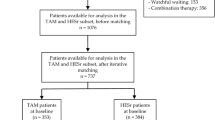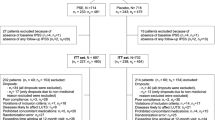Abstract
This 6-month double-blind, randomized, parallel-group study compared two dose regimens of Libeprosta®, the lipidosterolic extract ofSerenoa repens in 100 male outpatients with lower urinary tract symptoms suggestive of benign prostatic hyperplasia (BPH). The patients received two 80-mg tablets twice daily or two 80-mg tablets three times daily. Baseline evaluations included maximum and mean urinary flow rates, postvoid residual urine volume, and International Prostate Symptom Score (I-PSS) total and quality-of-life scores. Both regimens significantly reduced the I-PSS mean total score from baseline values (P < .001); improvements achieved statistical significance after month 3 and were maintained for the duration of the study. Significant improvements from baseline also occurred in quality-of-life scores, maximum and mean urinary flow rates, and residual urine volume (P < .05). The decrease in residual urine with both regimens was highly significant (P < .001). No significant differences in efficacy were noted between the two dose groups, and no treatment-related complications or clinical adverse events occurred. In this clinical study, the lipidosterolic extract ofSerenoa repens was a well-tolerated agent that may significantly improve lower urinary tract symptoms and flow measurements in men with BPH.
Similar content being viewed by others
References
Garraway WM, Collins GN, Lee RJ. High prevalence of benign prostatic hypertrophy in the community.Lancet. 1991;338:469–471.
US Bureau of the Census. Available at: www.census.gov. Accessed October 5, 2000.
Giannakopoulos X, Grammeniatis E, Gartzios A, Pappas G. Transurethral needle ablation (TUNA) of the prostate: preliminary results using the new generation TUNA III catheter on patients with symptomatic BPH controlled by a series of 50 patients using the TUNA III device.Eur Urol. 1996;30(suppl 2):986.
Giannakopoulos X, Filiadis I, Tsoumanis PH, Giannakis D, Baltogiannis D, Gartzios A. TUNA in symptomatic BPH: 12 months follow-up in a series of 100 treated patients: the Ioannina experience.J Endourol. 1996;8:962–963.
Giannakopoulos X, Zlotta AR, Schulman CC. Long-term evaluation of transurethral needle ablation of the prostate (TUNA) for treatment of benign prostatic hyperplasia (BPH): clinical outcome after 5 years.J Urol. 2001;165:293.
Zlotta AR, Schulman CC, Giannakopoulos X. Traitement par TUNA de l’hypertrophie benigne de la prostate: resultats a cinq ans. Presented at the 95th French Congress of Urology; Paris, France; November 14–17, 2001.
Denis L, McConnell J, Yoshida O, et al. Recommendations of the International Scientific Committee: the evaluation and treatment of lower urinary tract symptoms (LUTS) suggestive of benign prostatic obstruction. In: Denis L, Griffiths K, Khoury S, et al, eds.Proceedings of the 4th International Consultation on BPH. Plymouth, UK: Plymbridge Distributors; 1998:669–684.
McNicolas T. LUTS suggestive of BOP. What are the current practice patterns?Eur Urol. 2000; 39:26–30.
Lepor H, Williford WO, Barry MJ, et al. The efficacy of terazosin, finasteride or both in benign prostatic hyperplasia.N Engl J Med. 1996;335:533–539.
Gormley GJ, Stoner E, Bruskewitz RC, et al. The effect of finasteride in men with benign prostatic hyperplasia.N Engl J Med. 1992;327:1185–1191.
Nickel JC, Fradet Y, Boake RC, {raet al.} Efficacy and safety of finasteride therapy for benign prostatic hyperplasia. Results of a 2-year randomized controlled trial (the PROSPECT Study).Can Med Assoc J. 1996;155:1251–1259.
Wilton L, Pearce G, Edet E, Freemantle S, Stephens MDB, Mann RD. The safety of finasteride used in benign prostatic hypertrophy: a non-interventional cohort study in 14772 patients.Br J Urol. 1996;78:379–384.
Djavan B, Marberger M. A meta-analysis on the efficacy and tolerability of α1-adrenoceptor antagonists in patients with lower urinary tract symptoms suggestive of benign prostatic obstruction.Eur Urol. 1999;36:1–13.
Carraro JC, Raynaud JP, Koch G, et al. Comparison of phytotherapy (Permixon®) with finasteride in the treatment of benign prostatic hyperplasia: a randomized international study on 1098 patients.Prostate. 1996;29:231–240.
Levin RM, Das AK. A scientific basis for the therapeutic effects ofPygeum africanum andSerenoa repens.Urol Res. 2000;28:201–209.
Plosker GL, Brogden RN.Serenoa repens (Permixon). A review of its pharmacology and therapeutic efficacy in benign prostatic hyperplasia.Drugs Aging. 1996;9:379–395.
Iehle C, Delos S, Guirou O, Tate R, Raynaud JP, Martin PM. Human prostatic steroid 5 alpha-reductase isoforms: a comparative study of selective inhibitors.J Steroid Biochem Mol Biol. 1995; 54:273–279.
Bayne CW, Donnelly F, Ross M, Habib FK.Serenoa repens (Permixon®): a 5 alpha-reductase types I and II inhibitor—new evidence in a coculture model of BPH.Prostate. 1999;40:232–241.
Braquet M, Cousse H, Raynaud JP, Braquet PG. Effect of the lipidosterolic extract ofSermon repens (Permixon®) and its major components on basic fibroblast growth factor-induced proliferation of cultures of human prostate biopsies.Eur Urol. 1998;33:340–347.
McKeehan WL, Adams PS, Rosser MP. Direct mitogenic effects of insulin, epidermal growth factor, glucocorticoid, cholera toxin, unknown pituitary factors and possibly prolactin, but not androgen, on normal rat prostate epithelial cells in serum-free, primary cell culture.Cancer Res. 1984;44:1998–2010.
Theyer G, Kramer G, Assmann I, et al. Phenotypic characterization of infiltrated leukocytes in benign prostatic hyperplasia.Lab Invest. 1992;66:96–107.
Ragab A, Ragab-Thomas JMF, Delhoun A, et al. Effects of Permixon® (Sereprostat in Spain) on phospholipase A2 activity and on arachidonic acid metabolism in cultured prostatic cells.Acta Med. 1987;293–296.
Paubert-Braquet M, Cousse H, Mengia-Huerta JM, Braquet P. Effect of the lipidosterolic extract ofSermon repens (Permixon®) on the ionophore A23187-stimulated production of leukotriene B4 (LTB4) from human polymorphonuclear neutrophils.Prostaglandins Leukot Essent Fatty Acids. 1997; 57:299–304.
Di Silverio F, Monti S, Sciarra A, et al. Effects of long term treatment withSermon repens (Permixon®) on the concentrations and regional distribution of androgens and epidermal growth factor in benign prostatic hyperplasia.Prostate. 1998;37:77–83.
Barry MJ, Fowler FJ Jr, O’Leary MP, et al. The American Urological Association Symptom Index for benign prostatic hyperplasia.J Urol. 1992;148:1549–1557.
Chute CG, Panser LA, Girman CJ, et al. The prevalence of prostatism: a population-based survey of urinary symptoms.J Urol. 1993;150:85–89.
Donovan JL, Kay HE, Peters TJ, et al. Using the ICSOoL to measure the impact of lower urinary tract symptoms on quality of life: evidence from the ICS-“BPH” study. International Continence Society, Benign Prostatic Hyperplasia.Br J Urol. 1997;80:712–721.
Abrams PH. New words for old: lower urinary tract symptoms for “prostatism.”BMJ. 1994; 308:929–930.
Girman CJ, Jacobsen SJ, Guess HA, et al. Natural history of prostatism: relationship among symptoms, prostate volume and peak urinary flow.J Urol. 1995;153:1510–1515.
Simpson RJ, Fisher W, Lee AJ, Russell EB, Garraway M. Benign prostatic hyperplasia in an unselected community-based population: a survey of urinary symptoms, bothersomeness and prostatic enlargement.Br J Urol. 1996;77:186–191.
Barry MJ, Fowler FJ Jr, O’Leary MP, et al. Measuring disease-specific health status in men with benign prostatic hyperplasia.Med Care. 1995;33(suppl 4):AS145-AS155.
Abrams PH, Griffiths DH. The assessment of prostatic obstruction from urodynamic measurements and from residual urine.BrJ Urol. 1979;51:129–134.
Abrams PH, Griffiths DH, Hoefner K, et al. The urodynamic assessment of lower urinary tract symptoms. In: Chatelian C, Denis L, Foo KT, et al, eds.Benign Prostatic Hyperplasia. Plymouth, UK: Health Publication; 2001:227–281.
Boyle P. Some remarks on epidemiology of acute urinary retention.Arch Ital Urol Androl. 1998; 70:77–82.
Medina JJ, Parra RO, Moore RG. Benign prostatic hyperplasia (the aging prostate).Med Clin North Am. 1999;83:1213–1229.
Boyle P, Maisonneuve P, Steg A. Decrease in mortality from benign prostatic hyperplasia: a major unheralded health triumph.J Urol. 1996;155:176–180.
Abrams PH, Donovan JL, de la Rosette JJ, Scafer W. International Continence Society “Benign Prostatic Hyperplasia” Study: background, aims, and methodology.Neurourol Urodyn. 1997;16: 79–91.
Rhodes PR, Krogh RH, Bruskewitz RC. Impact of drug therapy on benign prostatic hyperplasia-specific quality of life.Urology. 1999;53:1090–1098.
Altwein JE. Obstructive benign prostatic hyperplasia: therapeutic aspects.Eur Urol. 1998;34:31–37.
Lowe FC, Fagelman E. Phytotherapy in the treatment of benign prostatic hyperplasia: an update.Urology. 1999;53:671–678.
Dreikorn K, Borkowski A, Braeckman J, et al. Other medical therapies. In: Denis L, Griffiths K, Khoury S, et al, eds.Proceedings of the Fourth International Consultation on BPH. Plymouth, UK: Plymbridge Distributors; 1998:635–659.
Wilt TJ, Ishani A, Stark G, MacDonald R, Law J, Mulrow C. Saw palmetto extracts for treatment of benign hyperplasia: a systematic review.JAMA. 1998; 280:1604–1609.
The 3rd International Consultation on BPH.Recommendations of the International Consensus Committee. St. Helier, Jersey: Health Publications; 1996.
Eri LM, Teeter KJ. α-Blockade in the treatment of symptomatic benign prostatic hyperplasia.J Urol. 1995;154:923–934.
Birch NC, Hurst G, Doyle PT. Serial residual volumes in men with prostatic hypertrophy.Br J Urol. 1988;62:571.
Descotes JL, Rambeaud JJ, Deschaseaux P, Faure G. Placebo-controlled evaluation of the efficacy and tolerability of Permixon® in benign prostatic hyperplasia after exclusion of placebo-responders.Clin Drug Invest. 1995;9:291–297.
Boyle P, Robertson C, Lowe F, Roehrborn C. Meta-analysis of clinical trials of Permixon® in the treatment of symptomatic benign prostatic hyperplasia.Urology. 2000;55:533–539.
Author information
Authors and Affiliations
Rights and permissions
About this article
Cite this article
Giannakopoulos, X., Baltogiannis, D., Giannakis, D. et al. The lipidosterolic extract ofSerenoa repens in the treatment of benign prostatic hyperplasia: A comparison of two dosage regimens. Adv Therapy 19, 285–296 (2002). https://doi.org/10.1007/BF02853174
Issue Date:
DOI: https://doi.org/10.1007/BF02853174




